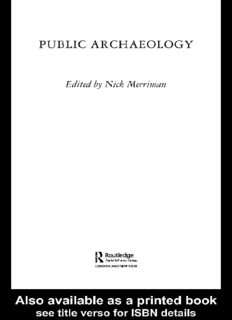
Public Archaeology PDF
Preview Public Archaeology
PUBLIC ARCHAEOLOGY Increasing public interest and participation in archaeology have ensured that the relationship between archaeology, heritage and the public is now studied as a subject in its own right. This volume, written by contributors from the UK, North and South America, Africa, Australia and China, provides a much needed survey of the relationship from an international perspective. The focus is on two key themes: communication and interpretation, and public stakeholders – the people or organisations who participate in archae- ology, from schoolchildren to state bodies. The case studies range from indigenous communities and archaeology, a scheme to bring treasure hunters and archaeologists together, and public archaeology in Brazil and the USA, to involving the public in museum archaeology, and the use of the Internet and the media to reach out to wider audiences. As one of the first books to concentrate on different aspects of public archae- ology around the world, this will be a valuable guide to the issues involved for both students and practitioners in archaeology and heritage. Nick Merriman is Reader in Museum Studies and Cultural Heritage at the Institute of Archaeology, University College London, and curator of UCL Museums and Collections. His previous publications include Beyond the Glass Case: The Past, the Heritage and the Public in Britain(1991, 2000) and Making Early Histories in Museums(1999). PUBLIC ARCHAEOLOGY Edited by Nick Merriman First published 2004 by Routledge 11 New Fetter Lane, London EC4P 4EE Simultaneously published in the USA and Canada by Routledge 29 West 35th Street, New York, NY 10001 Routledge is an imprint of the Taylor & Francis Group This edition published in the Taylor & Francis e-Library, 2004. © 2004 selection and editorial matter, Nick Merriman; individual chapters, the contributors All rights reserved. No part of this book may be reprinted or reproduced or utilised in any form or by any electronic, mechanical, or other means, now known or hereafter invented, including photocopying and recording, or in any information storage or retrieval system, without permission in writing from the publishers. British Library Cataloguing in Publication Data A catalogue record for this book is available from the British Library Library of Congress Cataloging in Publication Data has been applied for ISBN 0-203-64605-3 Master e-book ISBN ISBN 0-203-67323-9 (Adobe eReader Format) ISBN 0–415–25888–x (hbk) ISBN 0–415–25889–8 (pbk) FOR CAROLINE CONTENTS List of illustrations ix List of contributors xii Acknowledgements xiv 1 Introduction: diversity and dissonance in public archaeology 1 NICK MERRIMAN PART I Spreading the word: communication and interpretation 19 2 Public archaeology in the United States 21 JOHN H. JAMESON JR. 3 Archaeology and public education in North America: view from the beginning of the millennium 59 KAROLYN E. SMARDZ FROST 4 Involving the public in museum archaeology 85 NICK MERRIMAN 5 Uncovering ancient Egypt: the Petrie Museum and its public 109 SALLY MACDONALD AND CATHERINE SHAW 6 Presenting archaeology to the public: constructing insights on-site 132 TIM COPELAND vii CONTENTS 7 Archaeology and the British media 145 NEAL ASCHERSON 8 Towards a more democratic archaeology? The Internet and public archaeological practice 159 CAROL McDAVID PART II In the public interest? The stakeholders 189 9 Archaeology and authority in England 191 ROGER M. THOMAS 10 Public archaeology in Brazil 202 PEDRO PAULO A. FUNARI 11 Archaeology for whose interest – archaeologists or the locals? 211 BERTRAM MAPUNDA AND PAUL LANE 12 Public archaeology and indigenous communities 224 MIKE PARKER PEARSON AND RAMILISONINA 13 Archaeology in reverse: the flow of Aboriginal people and their remains through the space of New South Wales 240 DENIS BYRNE 14 The comforts of unreason: the importance and relevance of alternative archaeology 255 TIM SCHADLA-HALL 15 The Treasure Act and the Portable Antiquities scheme: a case study in developing public archaeology 272 ROGER BLAND 16 The effects of the antiquities market on archaeological development in China 292 DASHU QIN Index 300 viii ILLUSTRATIONS Figures 2.1 Thomas Jefferson, third president of the United States, is given credit by many for the first recorded observation of archaeological context in the widely read Notes on the State of Virginia, first published in 1787. Painting by Charles Willson Peale, Philadelphia, 1791, copyprint of oil on canvas. Courtesy of Independence National Historical Park Collection, Philadelphia (128). 23 2.2 A modern open shelter protects the Casa Grande, or ‘Big House,’ one of the largest and most mysterious prehistoric structures ever built in North America, at Casa Grande National Monument in Arizona. Photo courtesy of National Park Service. 24 2.3 1930s New Deal relief project: reconstruction of the prehistoric earthlodge at Ocmulgee National Monument, Georgia. Photo courtesy of National Park Service. 27 2.4 Aerial view of excavated area at the Rocker’s Bottom archaeological site, Richard B. Russell Reservoir, Georgia. Photo courtesy of National Park Service and US Army Corps of Engineers. 35 2.5 Interpretive rendering of a c. 7,000 year old Archaic period habitation scene from the Beneath These Waterspopular history volume. Painting by Martin Pate. Courtesy of Southeast Archeological Center, National Park Service. 35 2.6 Archaeological field crew working at the Rocker’s Bottom archaeological site, Richard B. Russell Reservoir, Georgia. Photo courtesy of National Park Service and US Army Corps or Engineers. 36 2.7 The reconstructed stockade fort at Ninety Six National Historic Site, South Carolina. Photo courtesy of National Park Service. 44 ix
Description: